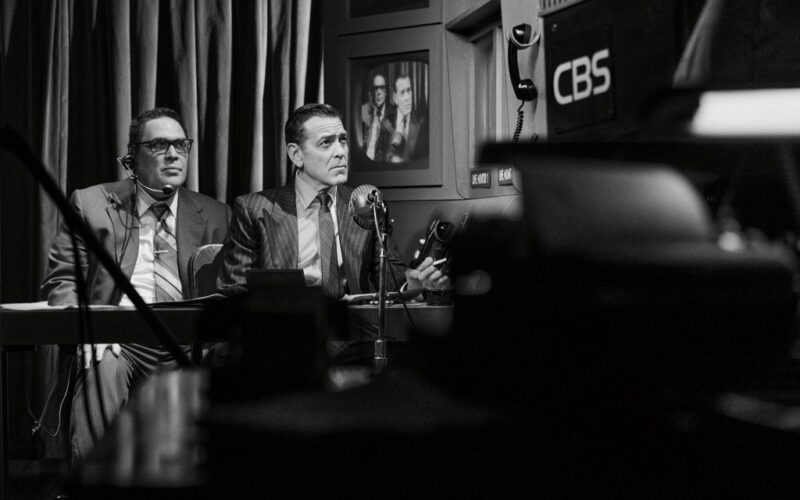When George Clooney walks out on stage as Edward R. Murrow, the distinguished American journalist, the chiseled Hollywood star gets the customary entrance applause. An ovation follows at the end of “Good Night, and Good Luck,” the recreation of a mid-century newsman’s battles with McCarthyism, too. But that doesn’t feel as much for Clooney as for Murrow and the values for which the newsman stood, a credit to Clooney, actually, and an indication surely of just how unmoored Americans feel right now.
Much cliched blather is spoken in the biz about old shows that seem ripped from today’s headlines. Human actions and conflicts don’t change much so it’s actually not that hard to seem prescient or pull off some resonance with the present day. But I’m telling you, on Wednesday night, even as Donald Trump was cutting the ship of global trade loose in perilous waters, blathering all the way up to curtain time, “Good Night, and Good Luck” felt like a custom-designed experience from Capt. Murrow, launched from beyond the grave that very day: “We will not walk in fear, one of another,” he says. “We will not be driven by fear into an age of unreason.”
In short, the brilliant director David Cromer has taken a mostly prosaic, procedural media drama about the CBS news program “See it Now,” as adapted from the screenplay of a 20-year-old movie penned by Clooney and Grant Heslov and turned it into something that scorches with the heat of today’s political turmoil.
Cromer is a detail fiend: thus, the massive stage of the Winter Garden Theatre is designed by Scott Pask with the veracity of a 1950s broadcast newsroom, all gruff, caucasian men in ties, cigarettes, sepia-toned TV images and the kind of communal energy that we current ink-stained wretches miss so much as we tap away on laptops.
Murrow’s reporting and commentary was broadcast live and that’s a byword here as everything clatters with real-time rhythms and Cromer’s constant collaborator, the lighting designer Heather Gilbert, uses her trademark practical lighting, a gorgeous evocation of the era of eyeshades, desk lamps and fizzing bulbs. The show also adds a little retro orchestra up in the rafters, with Georgia Heers singing as Ella Fitzgerald. Maybe that’s extraneous but it’s Broadway and it sets the mood.
Clooney offers a close study of Murrow that compares well with the real thing: His performance is, on occasion, under-vocalized for a venue of this size, but it’s wrought with great care and a willingness to be subsumed by character, not true of all stars of Clooney wattage. He joins readily with Glenn Fleschler, who plays the broadcasting legend and Murrow sidekick Fred Friendly; Clark Gregg, who plays the news writer Don Hollenbeck (who killed himself in 1954); Will Dagger (who plays famed producer Don Hewitt) and with Carter Hudson and Ilana Glazer, who play the married couple of Joe and Shirley Wershba and who offer some comic relief from all the mid-century testosterone.
The piece thankfully stops short of being a hagiography of Murrow: the point is made therein that by stepping so far out into partisan waters as distinct from just reporting the news, the great newsman opened the door to partisan attacks on a clearly partisan media. In other words, he unconsciously created a blueprint for those less fair and scrupulous than himself and for the ideological silos wherein Americans now get their confirmatory news.
It’s also worth stating that with ticket prices for this proudly left-leaning show flying up into the stratosphere, there’s a certain elitist disconnect at play, a symptom of our current problems.
Still, Cromer’s ace here was to operate on twin tracks: To recreate with precision how Murrow and his team turned Eugene McCarthy’s prosecutorial tactics back on the prosecutor himself and hung him on his own petard, but also to explicitly look forward to the media disintegration that followed.
In Act Two, there is a stunner of a video montage, credited to David Bengali, that looks like it was only created last week. Its finale involves Elon Musk, and it causes the audience to cry out with surprise, fear and recognition.




















